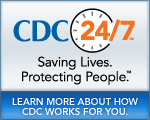MMWR
Morbidity and Mortality Weekly Report
MMWR News Synopsis for December 31, 2008
- Reduced Hospital Admissions of Acute Myocardial Infarction After Implementation of a Comprehensive Municipal Smoking Ban a€“ Pueblo, Colorado, January 1, 2002-June 30, 2006
- Campylobacter jejuni Infection Associated with Unpasteurized Milk and Cheese Consumption a€“ Kansas, 2007
- Legislative and Regulatory Impact of Underground Coal Mining Disasters a€“ United States, 2006
- (QuickGuide) Recommended Immunization Schedule for Persons Ages 0 Through 18 Years a€“ United States, 2009
There will be no MMWR telebriefing scheduled for December 31, 2008.
Reduced Hospital Admissions of Acute Myocardial Infarction After Implementation of a Comprehensive Municipal Smoking Ban a€“ Pueblo, Colorado, January 1, 2002-June 30, 2006
PRESS CONTACT: Terry Pechacek
Office of Smoking and Health
(770) 488-5493
Heart attack hospital admissions in the city of Pueblo, Colorado fell sharply after the implementation of a municipal law making workplaces and public places smoke-free, and this decrease was sustained over a three-year period. These findings suggest that smoke-free policies should be considered an important component of interventions to prevent heart disease morbidity and mortality. The study found that there were 399 hospital admissions for heart attacks in the city of Pueblo in the 18 months before a municipal smoke-free ordinance took effect on July 1, 2003, compared to 237 heart attack hospitalizations in the similar period from 18 months to three years after that datea€”a decline of 41 percent. No significant changes were observed in two comparison areas. Evidence indicates that secondhand smoke exposure can produce rapid adverse effects on the functioning of the heart, blood, and vascular systems that increase the risk of a cardiac event. Eliminating smoking in indoor spaces is the only way to fully protect nonsmokers from secondhand smoke exposure.
Campylobacter jejuni Infection Associated with Unpasteurized Milk and Cheese Consumption a€“ Kansas, 2007
PRESS CONTACT: Dr S Titilayo Aghoghovbia
Field EIS Officer, Kansas Department of Health and Environment
(785) 296-5588
To prevent milkborne infections, unpasteurized milk and unpasteurized milk products should not be consumed. On October 26, 2007, a family health clinic nurse informed the Kansas Department of Health and Environment (KDHE) that Campylobacter jejuni had been isolated from two ill persons from different families who were members of a closed community in a rural Kansas county. By October 29, 17 additional members of the community had reported gastrointestinal illness. All 19 persons reported consuming fresh cheese on October 20 that was made the same day at a community fair from unpasteurized milk obtained from a local dairy. This report summarizes the findings of an investigation by KDHE and the local health department to determine the source and extent of the outbreak. Eating fresh cheese at the fair was the only exposure associated with illness (RR = 13.9). Of 101 persons who ate the cheese, 67 (66 percent) became ill. C. jejuni isolates from two ill persons had indistinguishable pulsed-field gel electrophoresis (PFGE) patterns and the isolate from a third ill person was nearly identical to the other two. Although all samples of cheese tested negative for Campylobacter, results of the epidemiologic investigation found an association between illness and consumption of fresh cheese made from unpasteurized milk. To minimize the risk for illness associated with milkborne pathogens, unpasteurized milk and milk products should not be consumed, especially among populations at high risk of infection complications (the young, pregnant, elderly and immunocompromised).
Legislative and Regulatory Impact of Underground Coal Mining Disasters a€“ United States, 2006
PRESS CONTACT: Fred Blosser
NIOSH Public Affairs
(404) 202-0645
The occurrence of three fatal underground coal mining incidents within 5 months in 2006 was a departure from recent trends in underground coal mining safety. Historically, legislation and focused research have followed mining disasters, including the recent MINER Act of 2006. During a 5-month period in 2006, three underground coal mining incidents in the United States resulted in the deaths of 19 miners. The occurrence of three fatal incidents in 5 months was a departure from recent trends in underground coal mining safety. Before 2006, the number of mining disasters had decreased from a high of 20 in 1909 to an average of one every 4 years during 1985a€“2005. This report briefly describes the three 2006 mining incidents, reviews mining disasters in the United States during 1900a€“2006, and discusses the impact of the disasters and the 2006 incidents on mining health and safety regulations including the Mine Safety and Health Act of 2006.
(QuickGuide) Recommended Immunization Schedule for Persons Ages 0 Through 18 Years a€“ United States, 2009
PRESS CONTACT: CDC
Division of Media Relations
(404) 639-3286
No summary available.
####
- Historical Document: December 31, 2008
- Content source: Office of Enterprise Communication
- Notice: Links to non-governmental sites do not necessarily represent the views of the CDC.
View Press Releases in
Get e-mail updates
To receive e-mail updates about this page, enter your
e-mail address:
Contact Us:
- Centers for Disease Control and Prevention
1600 Clifton Rd
Atlanta, GA 30333 - 800-CDC-INFO
(800-232-4636)
TTY: (888) 232-6348 - Contact CDC-INFO


